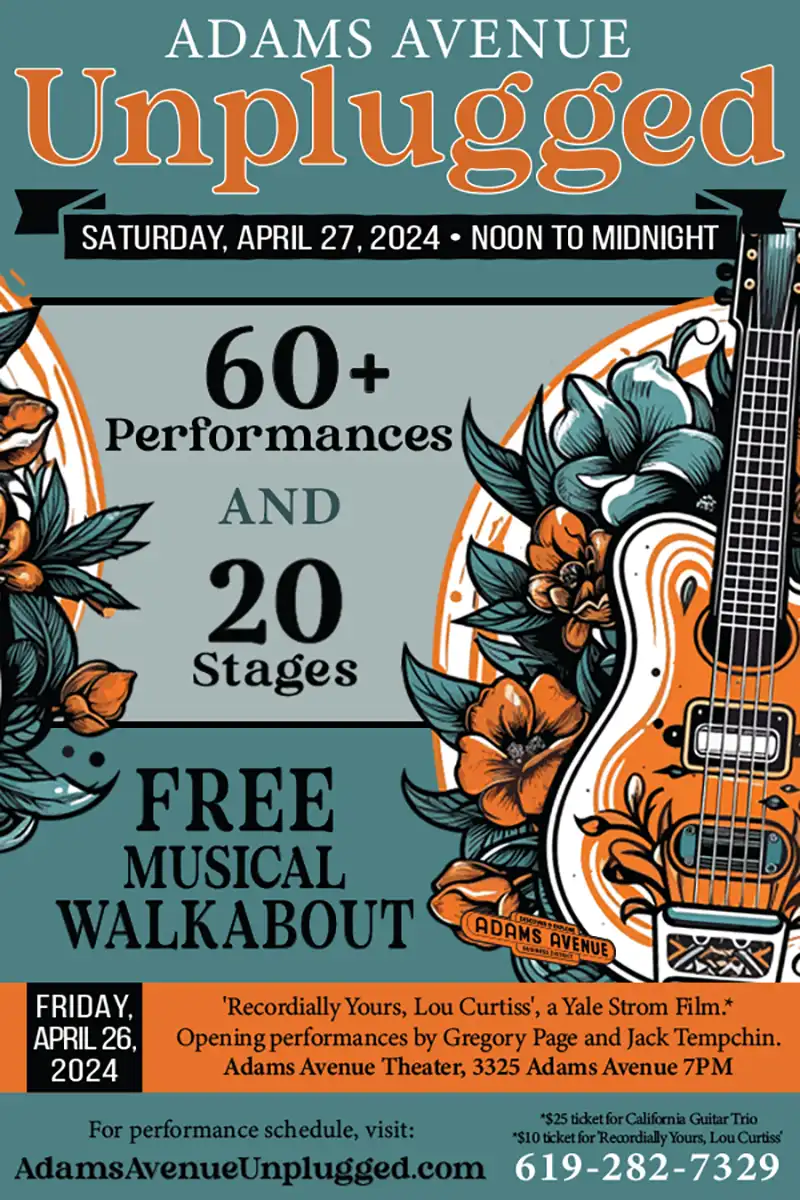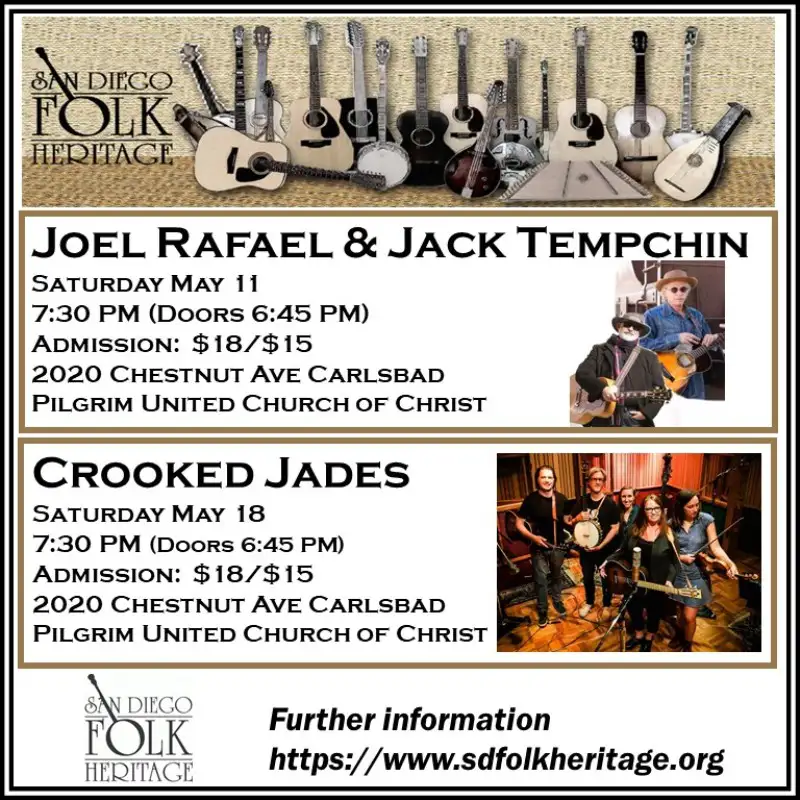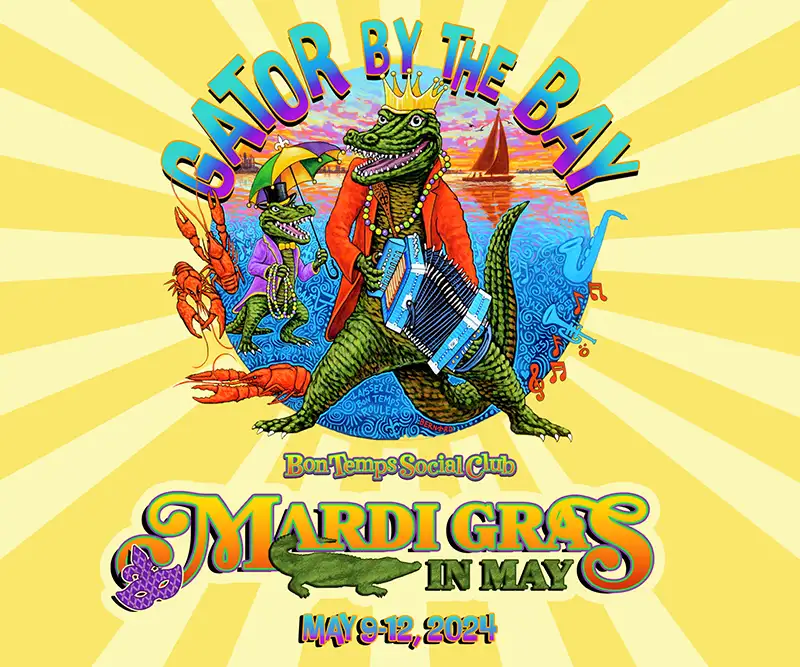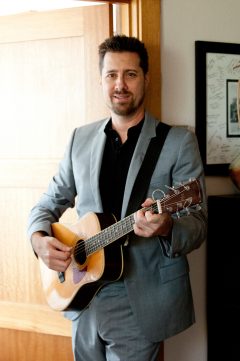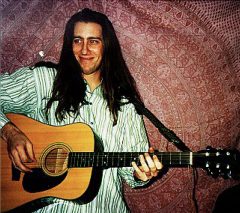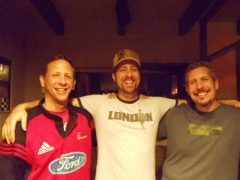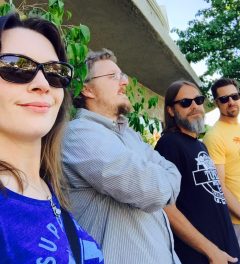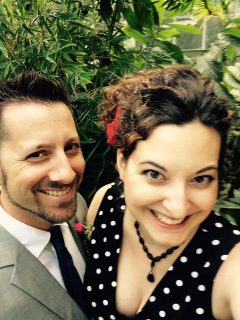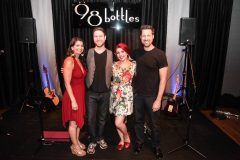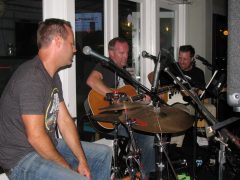Cover Story
Simeon Flick Steps in his Shoes
“As a young child, I’d never harbored any musical ambitions beyond just being a passive, avid listener–a fan. I occasionally look back on that simpler time and the unbiased lad I was with envy, wishing I could return to just being the pure listener that I was before my head got filled up with the discriminating knowledge of musicianship and recording techniques–before I gleaned the tools to vivisect everything I heard. Back then, the impetus to play and master several instruments could only be seen in the way I would meticulously build guitars and drum sets out of found items and paper cut-outs for group lip-syncs I orchestrated at my day care center. But, everything changed when my teen years began.”
FLICK OF THE SWITCH
For Simeon Flick, the question was never about whether or not to learn an instrument, but rather which one. Along with his brother, Nathan, the choice was obvious: drums. Drums or both. Every mother’s nightmare. The unholy noise would be more than any house could handle. But, Mom knew the strong-willed twins would not be satisfied until they both had their own kits to wail on.
This led to the guitar. Simeon got his first guitar when he was 14. Finding his ear early, he took about a month and a half of lessons before realizing he was fine on his own–engaging in the age-old story of all the players who came before, finding a new religion, getting lost in the new language of it for hours on end, saved by it, assuming control of his own pedagogy.
“I’m amazed I kept my school work up,” he notes.
Brother Nathaniel was into bass guitar, and they started their first band together sometime in ’85-’86–burning through a bunch of members before solidifying their eventual lineup as Nemesis, basically a power trio with sometimes added musicians.
Simeon, being the mastermind of the operation, meant they had a penchant for Rush tunes and original instrumentals with ambitious, space-filling chord-melody guitar parts and long solos over acrobatic bass lines.
A bright young Flickster, Simeon’s love of language began to express itself in the form of lyrics, around 1986. Simeon explains,
“Those songs were, of course, terrible, but they were inordinately imaginative. Where does an upper middle class, as-of-yet drug-free teetotaler get the idea for a song called ‘Hot Pursuit’ about a hash dealer on the lam from the law?!”
He attributes Rush, for his ability to already be using upper-harmony chords, suspensions, inversions, and adding little sub-melodies to everything. In his continued guitar learning, Van Halen was a huge formative influence, spending tens of hundreds of hours learning the guitar solos (and later the keyboard solos), with the barrage of arpeggios and right-hand tapping licks.
“I was also obsessed with learning Alex Lifeson’s (of Rush) solo on the Exit, Stage Left version of the instrumental piece ‘La Villa Strangiato.’ Sweeping through multiple dynamic levels and tones, it was utterly operatic in its technical and melodic scope, and I desperately wanted it under my fingers.” Simeon explains.
Simeon’s serious undertaking of the guitar continued with the pursuit of the classical guitar, something of which he considers more like a journey.
“The journey began with a couple of rudimentary lessons, with a guy over at Griffin Guitar in Palo Alto. Mom had finally lifted the embargo on her nylon string guitar, and I started composing pieces on it in tandem with the lessons. I think I had some piano lessons as college prep, but they didn’t really stick; keyboards were the domain of my parents, you see, and I had to stake my own unique melodic claim somewhere else. The guitar was the obvious choice, as the ’80s found guitar virtuosity at its highest, most visible peak and my young mind was blown with the possibilities of the guitar.”
Insatiably curious and hungry, Simeon continued playing music with Nemesis and other formative groups, engaging in and becoming extremely adept in a variety of music genres from progressive to classical to punk to arena rock and so on.
College is where everything gets interesting It was in the first few weeks of school, in the introductory music class at the University of Redlands, that Simeon found out he was the only one in a group of about 40 who had perfect pitch. The teacher started plunking out notes and honed in on him–naming them correctly and singularly from the back of the classroom. Within the year he tested out of Harmony II by taking the final–four-part dictation, where you listen to a “chorale” on the piano and write it all down in standard notation–a few months early. Something that afforded Simeon the extra luxury of sleeping in.
Simeon considers his classical training with the late Terry Graves (De Falla Guitar Trio) as life-altering.
“Terry had an undeniable impact on my guitar playing in general, as it started me in on a polyphonic approach, emphasizing not just the chord but the bass note and supplemental melodies. My arrangement abilities also got honed, as my transcriptions of Domenico Scarlatti’s keyboard sonatas necessitated funneling elaborate two-hand piano parts down to what was essentially a new composition for one hand. This aids and abets me today in being able to effectively carry a three-plus hour long solo gig, as my guitar parts are all-inclusive and supportive, not to mention being able to sing over it, as polyphony splits your multitasking brain in the necessary way.”
AND OF COURSE THERE WERE BANDS
During the first two years it was mostly covers-and-instrumental-originals-because-nobody-wanted-to-sing kind of groups. Simeon’s first real professional act was Crux. And their first show, as a matter of fact, was opening for a moderately successful band called Excel at Monopoly’s, a live music club in Riverside.
“We were speed metal-cum-grunge to a tee, all of us with long-ass hair, and me wearing white, cut-off painter’s overalls with no shirt underneath (OWW, nipples!) and Clark’s Wallabes on my feet. Most of us wore plaid flannel,” explains Flick.
Crux gigged throughout the Inland Empire and, later, Los Angeles (played the Whiskey a Go Go in the dying days of hair metal: “Hey, anybody got any black eyeliner?!”) as three of the four of them continued their higher education agendas.
“We actually played twice in San Diego, coming down to share a Che Cafe bill with Three Mile Pilot and Rob Crow’s Heavy Vegetable and a show with Rocket from the Crypt at the original Casbah location. We had our own label (Thick Records), through which we independently released two albums (Harvest, an EP, and Slump, an eight-song full-length with three outtakes), and that suited the maverick in me.”
Simeon graduated from the University of Redlands in 1992 and moved to Berkeley, also ending his tenure with CRUX. It was a chance at a new, post-collegiate life with his best friends from high school.
“We were just about to rent a place when I had all four of my guitars–a Gibson ES335, the aforementioned Les Paul, my Ramirez classical, and a Yamaha acoustic I called the ‘Glue model’ because you opened up the case and smelled the glue barely holding the cheap thing together!–stolen from the back of my truck. The stupid kid left his guitars in his truck overnight in a dense urban area populated by junkies and other wraiths!” Don’t know what he was thinking, but it did catalyze his return to Redlands, where a new band was waiting for him.
Simeon will boldly state that grunge served him well. “I’d had a lot of anger to channel into the live shows,” he explains, “but I could already feel a shift happening in the cultural ether.”
Mellower sounds like the Dave Matthews Band, Phish, Oasis, and Blues Traveler were starting to bubble up to the mainstream, and the new band Flick was recruited into (Sages of Memphis) seemed to presciently reflect that shift. It was a massive aesthetic move for Simeon, and he would enter Sages having recently purchased the only guitar that would assuage his recent loss: an alpine white, gold-hardware’d Gibson SG doubleneck, which he cheekily dubbed Excalibur for its–and the case’s hot pink interior–coloring. He also decided it was time to start singing.
Simeon had initially been recruited by his then friend Mike P. to play his music. In this arrangement Simeon explains the nature of the mentor/apprenticeship roles between himself and Mike P, being the assumed mentor.
“True, I needed to become a little less direct/clichéd and more abstract/poetic [he needed the opposite, which balanced us out in a Lennon/McCartney kind of way, only with a fraction of their brilliance, heh], but the writer in me had already been galvanized by the poetry class I’d taken during my senior year at the U of R. By the time I left the band in April ’97, I had put the work in and was writing material that was just as strong–as well as apropos; I had also learned to write for our band’s sound and instrumentation. However, Mike didn’t want to be my sideman; he wanted to keep the band as it was, to be the sole front man. I get it. But, that and the fact that he was content to be a big fish in a small regional pond, not tour our asses off or move to a place like San Diego–like I wanted to–and because, frankly, he was kind of a controlling jerk, which sealed that band’s fate for me.”
Within the first four months as a band, they had played all kinds of frat parties and school functions at the University of Redlands and got the amazing opportunity to open for Fishbone and School of Fish at Mayfest ’93. Sages played all kinds of gigs locally and opened for many well-known bands, including the Samples, the Untouchables, Sublime (at least twice, once at Loca-palooza ’94, Leftover Salmon, and very notably No Doubt at the Buena Vista theater outside of Phoenix.
“It was kind of funny watching them backstage; they were obviously impatient to ‘make it.’ Tragic Kingdom was about to come out and the promotional machine hadn’t quite kicked in yet.”
Simeon befriended Matt Nathanson, who was a student at Claremont College, where they would open shows for each other, taking turns.
“I played guitar for him at his Kohoutec Festival appearance in ’95, I believe, backed him at one or two other shows as well. I’m still on his mailing list, but he’s pretty much moved on to bigger and better things.”
Simeon’s social life pretty much revolved around Sages. Just after releasing their second album, Year of the Elephant (which was recorded with Jim Waters at Waterworks, in Tucson–John Spencer Blues Explosion recorded there). Simeon went to Scottsdale to celebrate his 27th birthday by having his brother Nat shave his head… and resolving to leave the Sages of Memphis.
“It was traumatic for everyone; feelings got hurt. I took withering blasts of vitriol from the guys, especially Mike, who funnily enough said he understood exactly why I had to leave. I had started jamming with Nat again and was ready to play my own music elsewhere, if Sages couldn’t accommodate me. However, he couldn’t reconcile himself to the shock of it. He brought his family out to the last couple of shows, and they gave me the stink eye and said mean things to me, booed me from the audience. I’ve heard that to this very day they’re still not cool with me. I can’t help them with that.”
Simeon left Redlands and went back to school as a graduate student in classical guitar at the University of Colorado, Boulder on a probational basis in late ’98.
“Probational” because I had picked up some bad habits on classical guitar that required remedial work. I spent the spring ’99 semester receiving what ended up being the best–and most expensive–five months of classical guitar instruction I’ve ever had.”
Still, he found it lonely there and never quite got settled in; he hadn’t made any friends outside of class or joined any bands. And, despite a 4.0 average he realized school was a dead end distraction from what he really wanted to do, which was to chase the pipe dream of being in a band with his brother Nat again.
“We did some recon in December/January ’00—’01, and moved to Pacific Beach in February. We had already renamed our ‘band’ Alpha Ray (after maternal grandmother Alpha and paternal grandfather Ray) and eventually conned Matthew Stewart into drumming and singing backgrounds for us,” explains, Flick.
They cut a three-song demo and got Tim Pyles to play “Tremore” on his local music radio show, which, of course, encouraged things for Alpha Ray. They played mostly as a duo at first, hitting open mics like Java Joe’s to little avail, and started a little performance duo/business called Duo Dynamic for weddings, corporate, etc. They played it out. Nat eventually moved on, got married and moved to New Zealand to start a family.
THE LONE FLICK
“I moved to Ocean Beach in ’02, which is where my solo career truly began.”
Infiltrating the scene, Simeon jumped into the open-mic circuit, meeting new people and making the connections to becoming San Diegan. He was asked to be a part of the bill for Terren Trousset’s December Reign benefit (for victims of 9/11) on December 15, 2001, with Matthew Stewart, Itai Faierman, and Lee Tyler Post, where he was introduced to Brian Strate, who was on standby to open his studio in Rancho Bernardo.
“We would get shitty on mixed drinks and record whatever songs I had ready,” relates Simeon. “He eventually moved the gear into an industrial park down the street and that place became Strate Sound, which operated until the late ’00s, and I was his first client, with my second album, Indigo Child, eventually coming out of there in August ’04. I did a bunch of session work for other bands there as well.”
In 2002 Simeon met Allison and they married in 2004. “The whole musician thing didn’t phase her; she supported it unconditionally, still does. She’s a keeper.”
Simeon cites his wife as a great influence and enabler for his creative work at his home studio, Blue Chair, which has been in operation since 2010.
“Having her support has been wildly instrumental in realizing my artistic potential, and I couldn’t have put out these almost seven albums without her. I’ve seen so many of my friends struggle without this kind of support in their creative lives, so I know how lucky I am,” Simeon explains, gratefully.
THE BEGINNING OF FLICK’S MOMENTUM IN SAN DIEGO
“Early February of ’04 was the big bang, the shot heard ’round the world, a life-changer of a gig. Alpha Ray played a show in Matthew Stewart and Jessica Treat’s living room with the Gandhi Method. All three members of that band had so much cachet individually and access to other as of yet unexplored pockets within the city’s scene. I could write a separate tome about all the doors that opened up from meeting those guys that night, how widely my professional and interpersonal universe suddenly expanded. I’m in the January ’07 Troubadour because of that gig.
“It’s very strange to think about now, considering the genre plateau I’ve arrived at, but becoming a predominantly acoustic guitar-slinging solo singer/songwriter was me rolling with the times again. It ushered me in to the whole Troubadour scene, gave me a platform, maybe even an audience, and definitely some great long-lasting friendships. Fredrick Leonard gave me my first CD review, my first press, and later the Troub would grace me with my first professional writing and journalism experiences.”
And Simeon has had a stable presence in the San Diego soundscape ever since. Deservingly so, because of the incredible and seasoned talent that is hallmark to his reputation.
At this point he’s on his own terms, focused on what he sees as the pure pursuit of pure music with no real avail to the general consensus. He’s having fun with his own work, while contributing as a sideman with other prolific pals in the scene.
“It has been an extremely difficult but rewarding process, especially early on when there were an inordinate amount of people telling me I shouldn’t be singing at all; I’m still singing. Right now I am eagerly continuing to earn my rhythm section wings with Christopher Dale (bass, percussion, vocals) and Podunk Nowhere (bass).”
Along the way Simeon has realized the necessity of going it alone, as some crucial friendships and working relationships faded out because of disagreements, misperceptions, and such. But, mostly, it came down to that work-in-progress realization that he knows exactly what he wants, how he wants it and has the capacity to do it, which has brought many conflicts with people who had their own often-contrary opinions about what he should be doing, and how he should be recording and performing.
“If I wanted my records to sound a specific way, I realized I would have to take up those reins as well. And as providence would have it, I actually wanted to.”
In 2008 he sang on a TV jingle for Dodge Jeep Chrysler at Singing Serpent that gave him the necessary windfall to invest in home studio equipment. It took a few years between albums (four, to be exact; Reactive Soul in 2006 to Piquant in 2010) to amass the necessary equipment and knowledge necessary to record on his own.
He continues with it to this day, while giving much of his gigging attention to his Scratch Acoustic Soul Trio since 2010–a successful, mostly covers, group, while maintaining his fierce sense of creativity.
“My latest project coming down the pipe is a five-song EP called Skein; it’s basically a protest album, very timely with what’s been happening in our world lately, only these songs, with the exception of one, are all years old now. There’s a time to put the rose-colored glasses on and take people out of their troubles for a time, and a time to drop the illusions to truthfully illuminate the ugliness, what’s urgently wrong with our present reality. I’m trying to get it finished by the time Trump is–or might be inaugurated–but something tells me it will still be pertinent months later, if not years. I guess it’s still me, finding some way to stay current, still open to what’s going on, rolling with and reflecting the times, even though I’ve chosen a combination of anachronistic genres in which to express it.”


